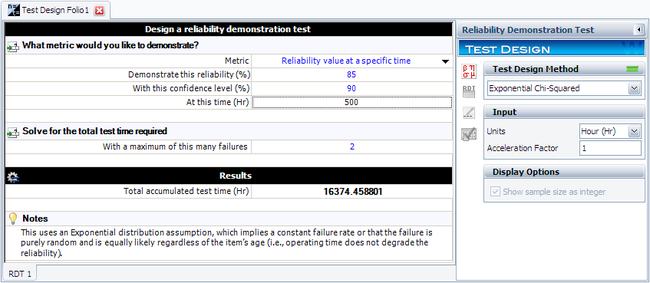Template:Example: Exponential Distribution Demonstration Test Example: Difference between revisions
Lisa Hacker (talk | contribs) No edit summary |
Chris Kahn (talk | contribs) No edit summary |
||
| Line 14: | Line 14: | ||
This example solved in Weibull++ is shown next. | This example solved in Weibull++ is shown next. | ||
[[Image: Test Design Chi-Squared.png|thumb|center| | [[Image: Test Design Chi-Squared.png|thumb|center|650px]] | ||
Given the test time, one can now solve for the number of units using the chi-squared equation. Similarly, if the number of units is given, one can determine the test time from the chi-squared equation for exponential test design. | Given the test time, one can now solve for the number of units using the chi-squared equation. Similarly, if the number of units is given, one can determine the test time from the chi-squared equation for exponential test design. | ||
Revision as of 10:27, 18 July 2012
Exponential Distribution Demonstration Test Example
In this example, we desire to design a test to demonstrate a reliability of 85% at [math]\displaystyle{ {{t}_{DEMO}}=500 }[/math] hours with a 90% confidence, or [math]\displaystyle{ CL=0.9, }[/math] and two allowable failures, [math]\displaystyle{ f=2 }[/math] . The chi-squared value can be determined from tables or the Quick Statistical Reference in Weibull++. In this example, the value is calculated as:
Substituting this into the chi-squared equation, we obtain:
This means that 16,374 hours of total test time needs to be accumulated with no more than two failures in order to demonstrate the specified reliability.
This example solved in Weibull++ is shown next.
Given the test time, one can now solve for the number of units using the chi-squared equation. Similarly, if the number of units is given, one can determine the test time from the chi-squared equation for exponential test design.
